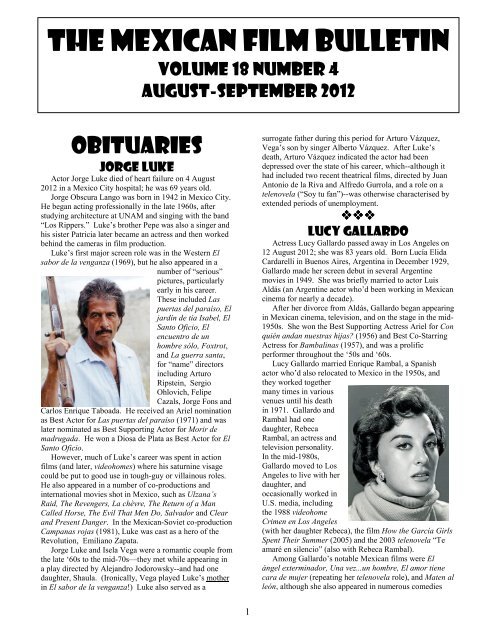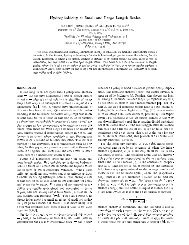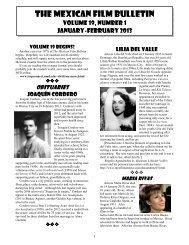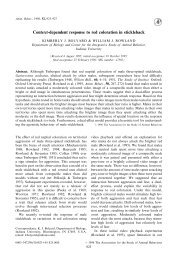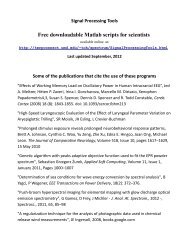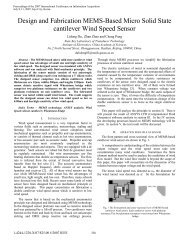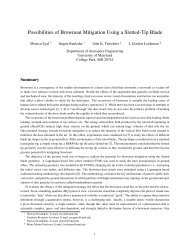Bonus Jorge Luke Film Review - TerpConnect
Bonus Jorge Luke Film Review - TerpConnect
Bonus Jorge Luke Film Review - TerpConnect
You also want an ePaper? Increase the reach of your titles
YUMPU automatically turns print PDFs into web optimized ePapers that Google loves.
The Mexican <strong>Film</strong> Bulletin, Volume 18 Number 4 (August-September 2012)<br />
The Mexican <strong>Film</strong> Bulletin<br />
Volume 18 Number 4<br />
August-September 2012<br />
Obituaries<br />
<strong>Jorge</strong> <strong>Luke</strong><br />
Actor <strong>Jorge</strong> <strong>Luke</strong> died of heart failure on 4 August<br />
2012 in a Mexico City hospital; he was 69 years old.<br />
<strong>Jorge</strong> Obscura Lango was born in 1942 in Mexico City.<br />
He began acting professionally in the late 1960s, after<br />
studying architecture at UNAM and singing with the band<br />
“Los Rippers.” <strong>Luke</strong>’s brother Pepe was also a singer and<br />
his sister Patricia later became an actress and then worked<br />
behind the cameras in film production.<br />
<strong>Luke</strong>’s first major screen role was in the Western El<br />
sabor de la venganza (1969), but he also appeared in a<br />
number of “serious”<br />
pictures, particularly<br />
early in his career.<br />
These included Las<br />
puertas del paraíso, El<br />
jardín de tía Isabel, El<br />
Santo Oficio, El<br />
encuentro de un<br />
hombre sólo, Foxtrot,<br />
and La guerra santa,<br />
for “name” directors<br />
including Arturo<br />
Ripstein, Sergio<br />
Ohlovich, Felipe<br />
Cazals, <strong>Jorge</strong> Fons and<br />
Carlos Enrique Taboada. He received an Ariel nomination<br />
as Best Actor for Las puertas del paraíso (1971) and was<br />
later nominated as Best Supporting Actor for Morir de<br />
madrugada. He won a Diosa de Plata as Best Actor for El<br />
Santo Oficio.<br />
However, much of <strong>Luke</strong>’s career was spent in action<br />
films (and later, videohomes) where his saturnine visage<br />
could be put to good use in tough-guy or villainous roles.<br />
He also appeared in a number of co-productions and<br />
international movies shot in Mexico, such as Ulzana’s<br />
Raid, The Revengers, La chèvre, The Return of a Man<br />
Called Horse, The Evil That Men Do, Salvador and Clear<br />
and Present Danger. In the Mexican-Soviet co-production<br />
Campanas rojas (1981), <strong>Luke</strong> was cast as a hero of the<br />
Revolution, Emiliano Zapata.<br />
<strong>Jorge</strong> <strong>Luke</strong> and Isela Vega were a romantic couple from<br />
the late ‘60s to the mid-70s—they met while appearing in<br />
a play directed by Alejandro Jodorowsky--and had one<br />
daughter, Shaula. (Ironically, Vega played <strong>Luke</strong>’s mother<br />
in El sabor de la venganza!) <strong>Luke</strong> also served as a<br />
1<br />
surrogate father during this period for Arturo Vázquez,<br />
Vega’s son by singer Alberto Vázquez. After <strong>Luke</strong>’s<br />
death, Arturo Vázquez indicated the actor had been<br />
depressed over the state of his career, which--although it<br />
had included two recent theatrical films, directed by Juan<br />
Antonio de la Riva and Alfredo Gurrola, and a role on a<br />
telenovela (“Soy tu fan”)--was otherwise characterised by<br />
extended periods of unemployment.<br />
��� ��� ��� ���<br />
Lucy Gallardo<br />
Actress Lucy Gallardo passed away in Los Angeles on<br />
12 August 2012; she was 83 years old. Born Lucía Elida<br />
Cardarelli in Buenos Aires, Argentina in December 1929,<br />
Gallardo made her screen debut in several Argentine<br />
movies in 1949. She was briefly married to actor Luis<br />
Aldás (an Argentine actor who’d been working in Mexican<br />
cinema for nearly a decade).<br />
After her divorce from Aldás, Gallardo began appearing<br />
in Mexican cinema, television, and on the stage in the mid-<br />
1950s. She won the Best Supporting Actress Ariel for Con<br />
quién andan nuestras hijas? (1956) and Best Co-Starring<br />
Actress for Bambalinas (1957), and was a prolific<br />
performer throughout the ‘50s and ‘60s.<br />
Lucy Gallardo married Enrique Rambal, a Spanish<br />
actor who’d also relocated to Mexico in the 1950s, and<br />
they worked together<br />
many times in various<br />
venues until his death<br />
in 1971. Gallardo and<br />
Rambal had one<br />
daughter, Rebeca<br />
Rambal, an actress and<br />
television personality.<br />
In the mid-1980s,<br />
Gallardo moved to Los<br />
Angeles to live with her<br />
daughter, and<br />
occasionally worked in<br />
U.S. media, including<br />
the 1988 videohome<br />
Crimen en Los Angeles<br />
(with her daughter Rebeca), the film How the García Girls<br />
Spent Their Summer (2005) and the 2003 telenovela “Te<br />
amaré en silencio” (also with Rebeca Rambal).<br />
Among Gallardo’s notable Mexican films were El<br />
ángel exterminador, Una vez...un hombre, El amor tiene<br />
cara de mujer (repeating her telenovela role), and Maten al<br />
león, although she also appeared in numerous comedies
The Mexican <strong>Film</strong> Bulletin, Volume 18 Number 4 (August-September 2012)<br />
like El día de la boda and Las fieras (both with Enrique<br />
Rambal).<br />
��� ��� ��� ���<br />
dulce kuri<br />
Dulce Kuri, who produced such<br />
Mexican films as Danzón, El jardín del<br />
Edén, and Frida, naturaleza viva, died<br />
of cardiac insufficiency in Mexico City<br />
on 11 August 2012; she was 64 years<br />
old.<br />
Kuri began working in the cinema<br />
industry in the 1970s, producing the<br />
documentary Viaje a Cuba, then<br />
working on various independent productions in the<br />
following decade, including ¿Cómo ves?, Frida,<br />
naturaleza viva, and Barroco. In the ‘90s and beyond she<br />
was responsible for projects like Danzón, Sobrenatural,<br />
Sin dejar huella, Crónica de un desayuno, and the<br />
animated feature La revolución de Juan Escopeta, her final<br />
film.<br />
Kuri is survived by her husband.<br />
chavela vargas<br />
Isabel Vargas Lizano, better known as singer<br />
Chavela Vargas, died in a Cuernavaca hospital on 5<br />
August 2012; she was 93 years old. Vargas was born in<br />
Costa Rica in 1919 and lived in poverty and illness as a<br />
child. Emigrating to Mexico as a teenager, she was<br />
allegedly discovered by José Alfredo Jiménez while<br />
singing on a street<br />
corner. Vargas’s<br />
interpretations of classic<br />
rancheras earned her<br />
fame, and she became<br />
friends with Frida<br />
Kahlo, Diego Rivera,<br />
and other well-known<br />
artists and intellectuals<br />
of the era. Later,<br />
Vargas succumbed to<br />
alcoholism and lost 15<br />
years of her career<br />
before making a comeback in the 1990s.<br />
Chavela Vargas recorded new albums, heard her songs<br />
used in various films (including multiple pictures by Pedro<br />
Almodóvar), and even appeared in several movies herself:<br />
Herzog’s Scream of Stone (1991), the English-language<br />
Frida (2002), and the documentary Hecho en México<br />
(2012). In her 80s she wrote her autobiography, revealing<br />
her homosexuality and other details of her long life and<br />
career.<br />
���<br />
Alberto Vázquez-Figueroa,<br />
novelist as director<br />
Some sources claim Alberto Vázquez-Figueroa is one<br />
of the most successful Spanish authors of popular fiction,<br />
having sold millions of copies of his many novels over the<br />
2<br />
past 30+ years. Born in the Canary Islands in 1936,<br />
Vázquez- Figueroa grew up in Africa and worked as a<br />
professional diver and globe-trotting journalist before<br />
devoting himself full-time to writing books (mostly<br />
fiction) after suffering a diving accident in the late '70s.<br />
Many of his books are set in exotic locations, including his<br />
first major success “Ébano” (1975, filmed as Ashanti in<br />
1979), “Manaos,” and “Tuareg.”<br />
Vázquez-Figueroa was involved with the cinema as<br />
early as 1971, when he collaborated on<br />
the screenplay of Es usted mi padre?<br />
Other film adaptations of his novels<br />
include El Perro (aka The Dog, 1977—<br />
this novel was later re-adapted into the<br />
2004 film Rottweiler), Tuareg (1984),<br />
Sangre en el Caribe (a Mexican-Spanish<br />
co-production, 1984), and Iguana (1988,<br />
directed by Monte Hellman).<br />
In 1976, the Spanish magazine “Blanco y negro”<br />
announced Vázquez-Figueroa was working on a film<br />
project about traffic in blood, to star Sandra Mozarowsky,<br />
Antonio Ferrandis, and Lola Gaos. This eventually<br />
became Oro rojo (1978), albeit with a completely different<br />
cast. Vázquez-Figueroa directed the film himself--shot on<br />
location in Lanzarote in the Canary Islands--as he did the<br />
following year with Manaos. The latter was a rare<br />
example of a novelist directing a film based on his own<br />
book (Oro rojo was based on an original screen story).<br />
Although he’s not directed any films since, Alberto<br />
Vázquez-Figueroa continues to be active as an author,<br />
winning the prestigious Premio Alfonso X El Sabio award<br />
in 2010 for his novel “Garoé.” He also devotes a<br />
considerable amount of his time and effort working on the<br />
process of desalination, with an aim towards increasing the<br />
world's potable water supply.<br />
��� ��� ��� ���<br />
Oro rojo (Sangre)<br />
[Red Gold—Blood]<br />
(Prods. Esme-Ízaro<br />
<strong>Film</strong>s, 1978)* Prod:<br />
Carlos Vasallo; Dir-Scr:<br />
Alberto Vázquez-<br />
Figueroa; Photo: José<br />
Luis Alcaine; Music:<br />
Carmelo Bernaola; Prod<br />
Dir: J. Estelrich; Asst<br />
Dir: Kuki López Rodero;<br />
<strong>Film</strong> Ed: Rosa Gracelia<br />
Salgado; Decor: Enrique<br />
Alarcón, Francisco<br />
Prosper; Makeup:<br />
Cristobal Criado; Prod<br />
Admin: José Luis Antón<br />
*Mexican-Spanish co-production<br />
Cast: Isela Vega (María), Hugo Stiglitz (Víctor), <strong>Jorge</strong><br />
<strong>Luke</strong> (Lucas Almeida), José Sacristán (Beni), Patricia<br />
Adriani (Aurelia), Terele Pavez (Rufa), Eduardo Bea<br />
(bodyguard), Carlos Ballesteros (Mr. Thompson), Alfredo<br />
Mayo (Aurelia’s father), Antonio Passy, Mónica Randall
The Mexican <strong>Film</strong> Bulletin, Volume 18 Number 4 (August-September 2012)<br />
(Raquel), Francisco Ortiz, Chelo Navarro (Aurelia’s<br />
neighbour), Fernando Baeza (Mr. Walter), Alejandro de<br />
Enciso, Antonio Gamero (ship’s captain), José Manuel<br />
Martín, Joaquín Pamplona (lawyer), José Yepes (doctor),<br />
Luis Barboo (Faro), José Riesgo (doctor), María José<br />
García Cortés, Juan Calvo, Alfonso del Vando, Alfonso<br />
Ortuño, Carlos Pisaca (prisoner), Fernando Corujo,<br />
Manuel de León, Alfredo Llorente, Nicolás Pérez<br />
Notes: Oro rojo was the first feature film directed by<br />
author Alberto Vázquez-Figueroa. In an article for the "El<br />
País" newspaper in September 1978, Vázquez-Figueroa<br />
wrote a "self-criticism" of the film:<br />
"It's an authentic story, told with honesty, directly, with<br />
marvelous photography by Luis Alcaine and some<br />
wonderful views that the island of Lanzarote has.<br />
The errors, which are numerous, each spectator will<br />
discover according to their own taste: inexperience in the<br />
handling of the actors or the camera, lack of rhythm or a<br />
connection between one sequence and the next...I don't<br />
know. If I had known, I wouldn't have committed such<br />
errors, of course. Overall, my opinion is that I have made<br />
a film that is 80% of what I wanted to make before I<br />
began, which isn't a bad percentage, in my way of looking<br />
at it...for a first [film]...it is [the story] I wanted to tell and<br />
in the form I wanted to tell it."<br />
Víctor, the bosun of a cargo ship plying the Caribbean<br />
trade, goes ashore on the island of Providencia, run by the<br />
dictator Almeida. His captain warns him the ship must sail<br />
on the morning tide or their cargo will rot. Spotting a<br />
shabby-looking man about to cook and eat a dead rat, the<br />
disgusted Víctor instead hires the man--Beni--as his guide.<br />
Beni takes him to prostitute Raquel, and then to a bar. He<br />
tells Victor that the Almeidas sold Providencia's fishing<br />
rights to a Japanese company, putting him out of work:<br />
now he and many others sell their blood to buy food.<br />
Leaving the bar, Víctor is mugged by some thugs, tipped<br />
off by Raquel. His ship sails without him. Discovered by<br />
Beni, Víctor says he can't apply for help to his consulate<br />
because he's a wanted man in his own country, and he can't<br />
get a berth on another ship because his seaman's papers<br />
(stolen from him) were false and can't be replaced.<br />
Víctor stays with Beni in a derelict fishing boat in the<br />
abandoned shipyard. Beni introduces him to his friend<br />
Aurelia (she's referred to as his "sister" once, but it's<br />
3<br />
unclear) and her elderly father. Since Beni is a known<br />
union member (from the old days) and Víctor is a<br />
foreigner, they can't find work and have to sell their blood.<br />
Beni signs a contract that will allow his organs to be<br />
harvested and his cadaver used for scientific research after<br />
his death, then gives the money to Víctor to purchase a<br />
new fake ID card. Once Víctor escapes from Providencia,<br />
he can send for Beni, Aurelia, and her father. However,<br />
Víctor is arrested by the secret police on suspicion of being<br />
a spy, and sent to a nearby island where convicts work in<br />
the salt flats.<br />
Meanwhile, Beni grows weaker from loss of blood.<br />
Aurelia is raped by Lucas Almeida, the playboy son of the<br />
island's president. Her father, shamed by his inability to<br />
protect or provide for his family, commits suicide by<br />
walking into the sea.<br />
After six months of hard labor, Víctor escapes from the<br />
prison colony and washes up on a rocky beach, where the<br />
lusty María and her bitter sister Rufa have a small cabin.<br />
María frankly admits she needs a man, and allows Víctor<br />
to stay--over her sister's objections--until he can repair<br />
their late father's fishing boat. When the boat is ready,<br />
María announces her intention to leave as well. Rufa,<br />
trying to shoot Víctor, accidentally kills María.<br />
Victor returns to Providencia but it is too late for Beni,<br />
who dies. Víctor and Aurelia burn his body so it won't be<br />
turned over to the Almeidas. Lucas Almeida tracks down<br />
Aurelia but Víctor kills several of the man's bodyguards<br />
and the dictator's son as well. Pursued by the police,<br />
Víctor discovers his former ship is in the harbor. The<br />
captain welcomes his errant crewman, but Victor returns to<br />
shore for Aurelia. The vengeful Rufa tries to kill him once<br />
more, but Aurelia saves the wounded Víctor and they row<br />
out to meet his ship. A printed message appears on the<br />
screen: "In more than a dozen countries today, there is<br />
traffic in human blood. Only united effort can stop the
The Mexican <strong>Film</strong> Bulletin, Volume 18 Number 4 (August-September 2012)<br />
most detestable commerce that man has been capable of<br />
inventing."<br />
Oro rojo is actually a very good film, despite the selfdeprecating<br />
comments of its author-director (in fact, it's<br />
better in many ways than his second movie, Manaos). The<br />
atmosphere of oppression, dread, and hopelessness of the<br />
island of Providencia is conveying in very convincing<br />
fashion, helped in no small measure by the location<br />
shooting on the bleak volcanic island of Lanzarote.<br />
Vázquez-Figueroa doesn't bludgeon the audience with too<br />
much symbolism: there are a few posters featuring the<br />
image of President Almeida (who's otherwise not seen in<br />
the movie), and the dictator's police are dressed in curious<br />
fashion (all-black cowboy outfits, dark glasses) and ride<br />
around in white jeeps, but these aren't overly obtrusive to<br />
the point of fantasy.<br />
The film also, surprisingly, is restrained in its depiction<br />
of the trafficking in blood. Lucas Almeida has a contract<br />
with Mr. Walter and Mr. Thompson--most likely<br />
Americans--to supply blood, but his company doesn't<br />
kidnap people or otherwise take their blood by force, it<br />
simply takes advantage of the government-created<br />
economic climate that gives the residents no other option.<br />
Late in the movie, Almeida tells a roomful of wealthy<br />
supporters that the government has purchased 40 pieces of<br />
heavy equipment that will free hundreds of poor<br />
campesinos from back-breaking labour. Of course, as one<br />
person remarks, that will mean those "poor campesinos"<br />
will now have to sell their blood to earn money, thereby<br />
enriching Almeida even further.<br />
Although Providencia is a fictional country, Beni does<br />
mention other dictatorial families who treat their nations<br />
like "private property"--the Duvaliers in Haiti, the<br />
Somozas in Nicaragua, and the Trujillos in the Dominican<br />
Republic--and Víctor says Providencia has a "fascist"<br />
government. And like another fascist government--in Nazi<br />
Germany--the minions of the Almeidas are scrupulous (in<br />
some ways) about legal matters: Beni signs a contract to<br />
4<br />
sell his cadaver, agreeing to comply with various<br />
restrictions imposed by the lawyer, the doctors at the blood<br />
company keep careful records (clients can only sell their<br />
blood once a week--although Víctor points out that once<br />
every two months is the safe interval), and so on.<br />
However, Lucas Almeida uses his thugs to ensnare<br />
Aurelia so he can rape her, several times (even though he<br />
has a sexy blonde as his constant companion), and<br />
otherwise abuses his position as the son of the island's<br />
dictator. Political prisoners are sent to the salinas (salt<br />
flats), where they are compelled to work in the blazing<br />
sun, raking briny seawater and extracting the salt crystals.<br />
Lucas at least gets his just deserts, shot to death by Víctor<br />
and left in the island's trash dump.<br />
The performances in Oro rojo are quite good overall,<br />
even though the standard Spanish-cinema post-dubbing<br />
robs some of the performers of their own voices.<br />
Interestingly enough, the dubbing in the version I've seen<br />
is not strongly "Castilian," suggesting this might be a<br />
Mexican release print (Isela Vega's top-billing also<br />
indicates this, since José Sacristan was the major "name"<br />
for the Spanish domestic market). <strong>Jorge</strong> <strong>Luke</strong> is certainly<br />
dubbed by someone else, while Isela Vega does her own<br />
voice (Hugo Stiglitz's voice is a toss-up). The dramatic<br />
heavy lifting is fairly evenly split between Sacristán and<br />
Stiglitz, with Patricia Adriani and Isela Vega providing<br />
substantial support. Vega, despite her top-billing and the<br />
prominent use of her image on the Mexican posters,<br />
doesn't appear until nearly an hour has elapsed and is onscreen<br />
for a relatively short period of time before her<br />
character is killed off, but she's very good nonetheless.<br />
In addition to the possibility of different dialogue<br />
tracks, it's also possible there were other differences<br />
between the Spanish-release and the Mexican-release<br />
versions of Oro rojo. Vásquez-Figueroa makes a point of<br />
saying the film contains "only a woman chastely nude for<br />
three seconds," whereas photos exist (see the lobby card on<br />
the previous page) which show Isela Vega naked (and not<br />
very "chastely"). I'm fairly certain I saw such footage<br />
years ago when I first watched the movie, but I'm not sure<br />
if Vásquez-Figueroa was referring to this scene, or to one<br />
brief shot of Almeida's blonde companion topless by a<br />
pool (she dresses extremely provocatively in every other<br />
scene she's in, but she's not nude), or something else. The<br />
version I watched for this review only includes the topless<br />
shot, not the Vega nude scene, and was further edited for<br />
language. However, the Spanish version was rated for<br />
audiences of 18-and-older, which suggests it might have<br />
contained more than "three seconds" of chaste nudity.<br />
Oro rojo is put together professionally, the narrative is<br />
straightforward, the location shooting contributes<br />
significantly to the feel of the film, and the performances<br />
are good. Overall, this is a satisfactory action-drama with<br />
substantial socio-political content.<br />
��� ��� ��� ���<br />
Manaos* (Prods. Esme-Ízaro <strong>Film</strong>s-The Federico G.<br />
Aicardi Org., 1979)** Exec Prod: Federico G. Aicardi,<br />
José Ma. Reyzabal; Prod: Carlos Vasallo; Dir: Alberto<br />
Vázquez-Figueroa; Scr: Alberto Vázquez-Figueroa, Carlos
The Mexican <strong>Film</strong> Bulletin, Volume 18 Number 4 (August-September 2012)<br />
Vasallo, Juan Antonio Porto; Orig. Novel: Alberto<br />
Vázquez-Figueroa; Photo: Alejandro Ulloa; Music:<br />
[Franco] Bixio, [Fabio] Frizzi, [Vince] Tempera; Prod<br />
Mgr: Salvador Gines, Pancho Medina; Asst Dir: Kuki<br />
López Rodero; Action Dir: Hernando Name; <strong>Film</strong> Ed:<br />
Sigfrido García, Otello Colangeli, Roger Macrosky; Art<br />
Dir: Kleomenes Stamatiades; Script Supv: Carlos Falomir;<br />
Dialog Coach: Carlos Nieto, John Fonseca; Camera Op:<br />
Cirilo Rodríguez; Second Unit Photo: Francisco<br />
Bojórquez; Brazilian Photo: Jean Marzon; Special FX:<br />
León Ortega; Sound Op: José García; Sound Ed: José Li-<br />
Ho; Makeup: Esther Oropeza, Franco Shioppa, Gianni<br />
Marosi; Re-Rec: Jesús González Gancy<br />
*aka Rebelión en la selva [Mexican release title]<br />
** Mexican-Spanish-Italian co-production<br />
Cast: <strong>Jorge</strong> Rivero (Howard), Andrés García (Carmelo<br />
Sierra), <strong>Jorge</strong> <strong>Luke</strong> (Ramiro), Miltón Rodrígues (Aranda),<br />
Carlos East (Charlie Scott), Carlos Nieto (Yusufaki), Wally<br />
Barrón (Saldaña), Mike Moroff [as "Manuel Burciagas" on<br />
Spanish version] (Joao), Alfredo Mayo (Sebastián),<br />
Alberto de Mendoza (Mario Buendía), Fabio Testi<br />
(Arquimedes), Agostina Belli (Claudia), Florinda Bolkan<br />
(Manuela Aranda), Miguel Fuentes & <strong>Jorge</strong> Reinoso [sic]<br />
(Sierra's bodyguards), Yogi Ruge (singer), Carlos Nieto<br />
(Yusufaki), Eduardo Noriega (Echevarría), John Fonseca<br />
(Blanchard), Kleomenes Stamatiades (Souza), Carlos<br />
González (Tigre), Humberto Johnson (Chino), Luis<br />
5<br />
Negrete (Blanquinegro), Lizetta Romo & Margarita<br />
Vernise (women), Manuel Anaya (Indio) [note: cast listed<br />
in Mexican-version order; the Spanish and Italian releases<br />
Manaos bill Belli, Testi, Rivero and García in that order]<br />
Notes: it's difficult to evaluate a film when a definitive<br />
version doesn't exist. Manaos received extensive<br />
international release, and various copies of different<br />
lengths and content<br />
are extant. For this<br />
review, I looked at 3<br />
versions [but I did<br />
not do a scene-byscene<br />
comparison.]:<br />
a) Manaos--just<br />
over 80 minutes in<br />
length; dubbed in<br />
Castilian Spanish;<br />
credits in English; contains nudity in the scene in which<br />
Claudia is raped. Found on the Internet somewhere.<br />
b) Rebelíon en la<br />
selva--just over 100<br />
minutes in length;<br />
dubbed in "Mexican<br />
Spanish"; credits<br />
altered; no nudity.<br />
Recently shown on<br />
Cine Nostalgia (a<br />
channel owned by<br />
Carlos Vasallo, one of<br />
the film's original producers).<br />
c) Manaos--just under 93 minutes long; Englishlanguage<br />
version (with sub-titles in some Scandinavian<br />
language); nudity in rape scene. Available on YouTube.<br />
For the record, if you look at the actors’ lip movements, it<br />
is apparent they were (mostly) speaking English during<br />
shooting, but the English-dubbed print is just that, a<br />
dubbed copy and not the original voice track.<br />
To confuse matters even more, another YouTube video<br />
has just the credits<br />
of a "VHS"<br />
version: these are<br />
English-language<br />
credits but the<br />
main title is<br />
animated and in a<br />
different font than<br />
the "other"<br />
English-credits version of Manaos, and the contents of the<br />
credit screens are different (for instance, Fabio Testi is topbilled,<br />
Belli second, Rivero third, each on a separate<br />
screen). Some of the other credits are missing (only Fabio<br />
Frizzi is credited with the music), some of the fonts are<br />
different, and the credits sometimes appear over different<br />
backgrounds than in the "other" versions (aerial shots of<br />
the Amazon in all cases, but not the same aerial shots).<br />
Furthermore, there is an extensive printed prologue (in<br />
English) that provides historical context, a prologue not<br />
present in Rebelión en la selva, or on either of the other<br />
two versions of Manaos I have!!
The Mexican <strong>Film</strong> Bulletin, Volume 18 Number 4 (August-September 2012)<br />
“Nearing the end of the nineteenth century, raw rubber<br />
came to be even more cherished that gold. It was obtained<br />
from a wild tree, which sprouted only within the Amazon<br />
Jungle.<br />
The monopoly of its exploitation lay only in the hands<br />
of a small group of men who, from MANAOS, turned the<br />
Amazon area into the largest prison known to human kind.<br />
During the rubber fever days, it is estimated that a<br />
million persons lost their lives in the Amazona.”<br />
There are other versions floating around, including a<br />
Condor Video of Rebelión en la selva that supposedly runs<br />
104 minutes.<br />
One would<br />
assume the<br />
longest version<br />
(in my case,<br />
Rebelión en la<br />
selva) comes<br />
closest to the<br />
original<br />
concept for the<br />
movie (except<br />
for the cut<br />
nudity and—<br />
probably—gore; also, most extant versions are full-screen<br />
rather than wide-screen). Regardless, Manaos is not an<br />
especially good film. Although it’s not dull, too much is<br />
left unexplained, some scenes run far too long, and the<br />
story is simultaneously too broad in scope and too narrow<br />
in execution. Like Vázquez-Figueroa’s first film, Oro<br />
Rojo, Manaos has a political viewpoint, but it is much<br />
more muted. The character of<br />
Arquímedes is introduced as a<br />
man who tried to start a<br />
revolution, and he later helps<br />
free some enslaved workers<br />
(and sends them away to<br />
Venezuela, out of danger), but<br />
he doesn’t verbalise his political<br />
beliefs and most of his actions<br />
seem simply like the decent<br />
thing to do, rather than a committed effort at social change.<br />
The oligarchs who control the rubber plantations are<br />
depicted negatively, but only Sierra’s atrocities are shown<br />
and the other men are not particularly evil (at least, not<br />
much more evil than all rich people in such movies are<br />
usually presented).<br />
As the film<br />
opens, rubber<br />
baron Carmelo<br />
Sierra arrives<br />
at one of his<br />
jungle<br />
plantations,<br />
accompanied<br />
by his mistress,<br />
Claudia.<br />
Working involuntarily on the plantation are Howard—a<br />
gringo who’d previously had an affair with Claudia—and<br />
Arquímedes, imprisoned for fomenting revolution. Sierra<br />
6<br />
hands over Claudia to the workers, ordering them to<br />
repeatedly rape her for her infidelity. Howard and<br />
Arquímedes are disgusted by this brutality, but are unable<br />
to intervene. Joao, Sierra’s foreman, plans to have<br />
Howard<br />
castrated by<br />
pirañas to<br />
avoid trouble,<br />
but<br />
Arquímedes<br />
warns his<br />
friend and<br />
Howard<br />
escapes,<br />
hiding in the<br />
jungle<br />
nearby. Arquímedes’s native assistant Ramiro offers to<br />
guide them to safety through the jungle, but Howard won’t<br />
leave without Claudia. Claudia murders Joao and they all<br />
set off for freedom.<br />
Their trek through the<br />
jungle is long and arduous.<br />
Claudia learns she is<br />
pregnant and has to undergo<br />
a painful miscarriage (aided<br />
by Ramiro) so she can<br />
continue. Sierra sends slaver<br />
Yusufaki after the fugitives<br />
but he is forced to free them<br />
in exchange for his own life<br />
when a hostile tribe of indigenous people steal their<br />
canoes. Howard, Arquímedes, Claudia and Ramiro reach<br />
the Ecuadorian border but are fired on by soldiers: Ramiro<br />
is mortally wounded and the others have to turn back.<br />
With the aid of disgruntled guard Sebastián, the group<br />
takes over a<br />
rubber camp,<br />
freeing the<br />
workers.<br />
They ambush<br />
the luxurious<br />
river boat of<br />
Sierra’s<br />
fellow<br />
exploiter<br />
Aranda.<br />
Aranda is betrayed by his own wife Manuela--appalled at<br />
his brutality towards his indigenous workers—and hung.<br />
Also on board the boat is gambler Mario, who knows<br />
Claudia’s family. Howard arranges for Mario to take<br />
Claudia home. As the boat passes the city of Manaos,<br />
Howard and Arquímedes disembark to find and kill Sierra,<br />
sending the others away to freedom and safety.<br />
Sierra and the other rubber barons have learned a<br />
British agent has stolen rubber seeds and a rival rubber<br />
industry is becoming established in the Far East. Sierra<br />
disposes of his holdings and makes plans to depart for<br />
Borneo with a cargo of the prohibited seeds himself. On<br />
Yusufaki’s houseboat (where the seeds are hidden), he’s<br />
assaulted by Howard and Arquímedes. Howard is killed,
The Mexican <strong>Film</strong> Bulletin, Volume 18 Number 4 (August-September 2012)<br />
but Arquímedes locks Sierra in the boat and watches as it<br />
plunges over a waterfall, killing the villain.<br />
How much of Manaos was shot in Brazil is debatable—<br />
the Estudios Churubusco and locations in the states of<br />
Tabasco and Chiapas probably account for much of the<br />
footage. The production values are adequate if not<br />
exorbitant—the “sets” are mostly shacks in the jungle,<br />
there aren’t huge crowds of extras, and there is no<br />
spectacle to speak of. The cast, on the other hand, is<br />
strong, and fairly evenly balanced between the<br />
participating countries-- Rivero, García, <strong>Luke</strong> (Mexico),<br />
Belli, Testi, Bolkan (Italy), de Mendoza, Mayo (Spain)--<br />
although ironically Spain seems to be the minor partner in<br />
this respect, since its “names” are supporting players.<br />
Given that most of the movie was filmed in Mexico, the<br />
presence of numerous Mexican character actors in the<br />
cast—Rodrígues, East,<br />
Barrón, Nieto, etc.--is<br />
understandable.<br />
Judging performances in a<br />
dubbed film is difficult, but<br />
most of the players are<br />
satisfactory. <strong>Jorge</strong> Rivero and Fabio Testi are both<br />
handsome, bearded heroes and since their back-stories are<br />
negligible, there isn’t much to choose between them.<br />
Andrés García makes a nice, arrogant villain and Agostina<br />
Belli is attractive.<br />
Alberto Vázquez-Figueroa was primarily a writer, and<br />
while Manaos isn’t badly-directed, it’s certainly not<br />
inspired, either. Too many scenes consist of people sitting<br />
around talking, and the “exciting” action sequences are<br />
either minimally<br />
competent or less<br />
than that. The<br />
assault on<br />
Aranda’s<br />
riverboat is one<br />
example, running<br />
too long and<br />
featuring boring<br />
footage of people shooting, intercut with shots of stuntmen<br />
stiffly falling off the craft into the river. Most of the movie<br />
is shot in medium shot or plan americain, and isn’t framed<br />
or edited for maximum dramatic impact.<br />
The music is also variable. Many reviewers have<br />
commented on the theme song, which is an extremely<br />
catchy if anachronistic disco tune (in English). Half the<br />
lyrics are unintelligible, but the words include “Manaos,<br />
that is where we are going, today, Manaos! Keep on<br />
moving or lose your way, caramba! If they catch us we all<br />
are gonna die...Manaos! Tried so hard to get along but they<br />
just wanna fight...” Unfortunately, the rest of the score<br />
vacillates between occasional instrumental versions of the<br />
theme, dramatic orchestral music (appropriate), and treacly<br />
7<br />
library-sounding music (inappropriate). [Note: it’s<br />
possible the different versions have altered music tracks as<br />
well as dialogue tracks.]<br />
Manaos is an adequately entertaining<br />
historical/jungle/action-drama with a good international<br />
cast, but it’s not an especially well-made film.<br />
���<br />
two José Bohr films<br />
Quién mató a Eva? [Who Killed Eva?] (Prods.<br />
Duquesa Olga, 1934) Dir: José Bohr; Adapt: Eva<br />
Limíñana; Story: Xavier Dávila, Eva Limíñana; Photo:<br />
Alex Phillips; Music: José Bohr; Music Arr: Max Urban;<br />
Asst Dir: Miguel M. Delgado; <strong>Film</strong> Ed: José Marino; Art<br />
Dir: F.A. Rivero; Asst Photo: Agustín P. Delgado; Sound:<br />
José B. Carles; Titles: C. Véjar Jr.<br />
Cast: José Bohr (José Rolán*), Josefina Vélez (Nancy),<br />
Julio Villareal (Mario Rosales), Miguel M. Delgado<br />
(Raúl), Joaquín Busquets (César), Lucy Delgado<br />
(Dolores), Alfonso S. Tello (González, detective), Nellie<br />
Parodi (Delia Medina), L. Sánchez Tello (Capt. Lobo),<br />
detectives: <strong>Jorge</strong> Treviño, Arturo Manrique, Santiago<br />
Ramírez; Carlos López "Chaflán" (drunk)<br />
*some sources list Bohr's character name as "José<br />
Roldán," but the film's opening credits and a newspaper<br />
clipping shown in the movie indicate it is actually Rolán.<br />
Notes: José Bohr was born in Germany in 1901, but<br />
traveled with his family to Turkey, Marseilles, and<br />
Argentina before finally settling in Chile as a boy. His<br />
career as an actor and singer eventually brought him to the<br />
USA, where he appeared in some of the Spanish-language<br />
versions of Hollywood films made in the early years of<br />
sound. Relocating to Mexico, Bohr directed and starred in<br />
his first film there in 1933. Quién mató a Eva? was the<br />
second of 14 features he would direct in Mexico between<br />
1933 and 1939, at which time he left the country,<br />
eventually returning to Chile where he made more than a<br />
dozen more films over the next two decades.<br />
Quién mató a Eva? is interesting in a number of ways,<br />
although it's not as entertaining as it had the potential to<br />
be. After a group of young women say in unison
The Mexican <strong>Film</strong> Bulletin, Volume 18 Number 4 (August-September 2012)<br />
"Duquesa Olga presenta," the opening credits are shown<br />
over live footage of Bohr's character conducting an<br />
orchestra and singing, a very unusual format for the period<br />
(credits over live-action were rare until the 1960s, and<br />
even then the on-screen action was usually "traveling"<br />
shots rather than dialogue scenes or musical numbers).<br />
Later, there are some<br />
odd musical<br />
interpolations: a quartet<br />
of comedy detectives<br />
sings their own "theme<br />
song" not once but<br />
twice, a group of four<br />
seedy-looking<br />
characters in a café<br />
perform a "scat-singing"<br />
number followed by two other, abbreviated songs. Bohr's<br />
opening song is entitled (in translation) "How Bored I<br />
Am," and sets up the plot; when he reprises the song a few<br />
minutes later, the lyrics are changed because he's not bored<br />
any more!<br />
Wealthy playboy José Rolán comes home to find<br />
burglar Mario Rosales in his house. José agrees not to call<br />
the police if Mario makes him his partner: José wants<br />
danger and excitement in his life. They move on to<br />
Mario's next target, but discover the owner of the house-actress<br />
Eva Urquiza--has been stabbed to death. The two<br />
men narrowly escape the<br />
police, but José leaves his<br />
hat behind and has to go<br />
into hiding. Mario takes<br />
him to the hotel run by<br />
Nancy, introducing him as<br />
gangster "Luponini from<br />
Chicago." Also in the hotel<br />
are Delia and Dolores:<br />
Dolores was Eva's secretary<br />
and Delia is her friend. José and Mario realise they must<br />
solve the crime to clear their names. However, Mario is<br />
murdered and Dolores is abducted. José eventually sets a<br />
trap that exposes Nancy's boyfriend Raúl as the murderer-they<br />
were blackmailing Eva. Raúl is killed fleeing from<br />
the police and Nancy is arrested.<br />
Too much of Quién mató a Eva? is spent running<br />
around pointlessly, and the dialogue and performances are<br />
never as amusing as the<br />
film pretends. José doesn't<br />
do much investigating:<br />
most of the clues fall into<br />
his lap, and Delia is actually<br />
the one who ascertains who<br />
sent Eva a parrot on the last<br />
day of her life (it was Raúl).<br />
The characterisations are<br />
uneven and their motivations are unclear or illogical for<br />
the most part. There are also too many coincidences.<br />
José Bohr is an engaging performer (curiously, he has<br />
an Argentine accent when he sings, but not when he talks)<br />
and one wishes the script had taken better advantage of his<br />
breezy personality. For those who are most familiar with<br />
8<br />
Julio Villareal's later roles as a curmudgeon, it's interesting<br />
to see him play a different sort of part here. Josefina Vélez<br />
was the sister of Lupe Vélez and the ex-wife of Miguel M.<br />
Delgado, who plays her<br />
lover in Quién mató a Eva?<br />
(apparently they remained<br />
on good terms after<br />
separating). As "Nancy,"<br />
she's wry, sexy, and<br />
independent, sparring<br />
verbally with José when he<br />
arrives at her hotel.<br />
The production values are adequate. The film<br />
concludes with a car chase and wreck, in which a car<br />
actually crashes into a ravine, an unexpected luxury.<br />
However, most of the film was shot in the studio on rather<br />
nondescript sets.<br />
It should be noted that the version of Quién mató a<br />
Eva? shown on Cine Nostalgia is missing a large amount<br />
of footage from the original--up to 20 minutes, if the<br />
original running time of 80 minutes is correct--including<br />
several additional songs by Bohr and one by Josefina<br />
Vélez. Although the plot seems more or less intact, the<br />
absence of the musical numbers is unfortunate.<br />
���<br />
Luponini de Chicago* [Luponini of Chicago]<br />
(Prods. Duquesa Olga, 1935) Dir: José Bohr; Adapt: Eva<br />
Limíñana<br />
"Duquesa<br />
Olga," José<br />
Bohr; Story:<br />
Xavier<br />
Dávila;<br />
Photo: Alex<br />
Phillips;<br />
Music: José<br />
Bohr; Orch:<br />
C. Jaramillo;<br />
Asst Dir:<br />
José<br />
Benavides;<br />
<strong>Film</strong> Ed:<br />
José Marino;<br />
Art Dir: José<br />
Rodríguez;<br />
Sound: B.J.<br />
Kroger<br />
*some<br />
advertisements for the film list the title as Luponini (El<br />
terror de Chicago), but most print sources give the title as<br />
Luponini de Chicago; the re-release (García Riera says<br />
"pirated")title was El Manos sangrientas (Bloody Hands)<br />
Cast: José Bohr (Luponini), Anita Blanch (Luisa<br />
Benítez), Carlos Villatoro (Chato), Isabelita Blanch<br />
(Isabel), Maruja Gómez (Maravilla), Raúl Talán (Colibrí),<br />
Manuel Buendía (Domínguez, chief of detectives), Arturo<br />
Manrique (Moreno), <strong>Jorge</strong> Treviño (Montes), Paco
The Mexican <strong>Film</strong> Bulletin, Volume 18 Number 4 (August-September 2012)<br />
Martínez (Luponini's father), G[odofredo] de Velasco<br />
(Juan Orlando), Consuelo Segarra (Sra. Benítez),<br />
Ernestina Estay<br />
Notes: one of José Bohr's best-known films today is<br />
Luponini de Chicago, a Hollywood-style gangster film. In<br />
Quién mató a Eva?, Bohr's character used the "Luponini<br />
de<br />
Chicago"<br />
pseudonym,<br />
implying he<br />
was a<br />
gangster,<br />
and<br />
returned to<br />
the name<br />
and<br />
profession<br />
here. The<br />
film opens<br />
with a<br />
printed title indicating "The action occurs in any country in<br />
the current day"--it clearly doesn't take place in Chicago,<br />
but rather a unnamed Mexico City--and the explanation of<br />
the "Chicago" part of the title only comes about half-way<br />
through the movie. The police learn Luponini was born in<br />
Chicago and lived there until he was 15 years of age, but<br />
there is no suggestion he is supposed to be an American<br />
gangster or even that he learned his trade there.<br />
Unfortunately, as with a number of the un-restored<br />
films being shown on the Cine Nostalgia channel,<br />
Luponini de Chicago (or to be more precise, the re-release<br />
version titled El Manos sangrientas) is severely cut. All of<br />
Bohr's musical numbers are missing (as are all but one<br />
fragment of those performed by Maruja Gómez), and the<br />
first 20 minutes of the movie have been severely truncated,<br />
omitting a lot of expository material.<br />
Luponini (his first name isn't given, and his friends call<br />
him "Lupo" anyway) is a teller at the Banco de Comercio.<br />
He's in love with Marta,<br />
daughter and secretary of<br />
bank president Orlando,<br />
but Orlando doesn't<br />
consider Lupo a sociallyacceptable<br />
match for her.<br />
Stung by Orlando's<br />
attitude, Lupo steals a car<br />
and takes fellow teller<br />
Luisa to a fancy dance, also attended by the Orlando<br />
family. Although he is not prosecuted for theft, Luponini<br />
loses his job. For some reason (the missing footage would<br />
have been helpful here), Lupo is also compelled to marry<br />
Luisa. Months go by, and Luisa and her mother become<br />
frustrated at Lupo's failure to get a job. Instead, he hangs<br />
out in a billiard hall with would-be crooks Chato and<br />
Colibrí. Finally, through the intervention of Chato's<br />
girlfriend Isabel, Lupo is hired by the Cine Esperanza as a<br />
projectionist, but it is too late to save his marriage: Luisa<br />
divorces him. Luponini bitterly says she would love him if<br />
he were rich, and vows to some day throw money in her<br />
face.<br />
9<br />
Luponini, Chato, and Colibrí form a gang and begin<br />
robbing banks and other businesses. Due to his athletic<br />
leaps during the<br />
crimes, Lupo is<br />
dubbed the "Hombre<br />
Mono" (Ape Man).<br />
One day, they rob<br />
the Banco de<br />
Comercio. Lupo is<br />
masked but Luisa<br />
gazes into his eyes<br />
and--when he tosses money at her--recognises the Hombre<br />
Mono as Lupo. She refuses to denounce him to the police,<br />
and is fired from the bank. Because she knows his<br />
identity, Lupo forces Luisa to leave home and join the<br />
gang, although he has a new girlfriend, Spanish dancer<br />
Maravilla. Their headquarters is in a cabaret conveniently<br />
located next to the Cine Esperanza: Lupo sings, Maravilla<br />
dances and sings, and even Luisa is pressed into service as<br />
a tap dancer. There is considerable friction between Luisa<br />
and Maravilla.<br />
A planned robbery of the nightclub goes awry. Lupo's<br />
identity as the Hombre Mono is exposed; he flees with<br />
Chato, Isabel, and Colibrí, with the police in hot pursuit.<br />
Chato and Colibrí are killed. [note: printed sources say<br />
Colibrí turned informant and Lupo kills him, but this is<br />
unclear in the extant version.] Lupo tells Isabel to return<br />
to the city and wait for his message. His car goes off a<br />
cliff and he is presumed<br />
dead, but Lupo survives<br />
and visits a plastic<br />
surgeon, who makes him<br />
look Asian (!). He is<br />
reunited with Luisa and<br />
Isabel, but Luisa<br />
succumbs to police<br />
pressure and tells them<br />
Lupo will be at the Cine<br />
Esperanza watching<br />
Maravilla perform. At the cinema, Lupo proposes that he<br />
and Luisa re-marry and leave the country. She leaves the<br />
cinema first but she and Isabel are prevented by the police<br />
from warning Lupo about the ambush. Lupo is mortally<br />
wounded. Believing Luisa betrayed him for money, Lupo<br />
shoots her. They both die.<br />
The conclusion of Luponini was obviously inspired by<br />
the then-recent demise of John Dillinger (he was killed in<br />
July 1934, a year before Luponini went into production):<br />
the police, tipped off by a woman, gun down the Most-<br />
Wanted gangster as he is leaving a cinema. Similarly,<br />
Lupo's career as a bank robber is somewhat reminiscent of<br />
Dillinger's crime spree, and Bohr even sports a pencil-thin<br />
moustache once he leaves the honest life behind.<br />
In most aspects, Luponini is far superior to Quién mató<br />
a Eva? The story is straight-forward, the production<br />
values are somewhat better (including some interesting<br />
location shooting), and the characterisations are more<br />
detailed. Luponini starts off as a fairly normal young man<br />
who is angered by the socio-economic bias of his boss at<br />
the bank. This develops into a sort of mania, whereby
The Mexican <strong>Film</strong> Bulletin, Volume 18 Number 4 (August-September 2012)<br />
Lupo feels<br />
everyone<br />
(except<br />
himself, of<br />
course) is<br />
motivated by<br />
money, and<br />
this is<br />
manifested in<br />
their rejection<br />
or ill-treatment<br />
of him. The<br />
relationship<br />
between Lupo<br />
and Luisa is<br />
odd--as noted<br />
above, the<br />
reasons why<br />
she is forced to marry him are unclear, and their marriage<br />
doesn't exactly blossom. Lupo is attracted to Luisa--but<br />
still cares about Marta--and Luisa is interested in him yet<br />
(egged on by her mother) criticises him for his failure to<br />
obtain honest employment and then divorces him. He is<br />
cool (even hostile) to her when they meet again, yet Luisa<br />
seems to be carrying a torch, although Lupo's now<br />
involved with Maravilla. Luisa's actions are almost entirely<br />
motivated by jealousy from this point onward. At the<br />
finale Lupo claims she's the one he's really loved all the<br />
time (even though he's still infatuated with Maravilla, at<br />
least enough to risk going to see her perform), and then-just<br />
before he dies--decides Luisa turned him in for the<br />
reward and kills her!<br />
The performances are generally very good, starting with<br />
Bohr, who--as just indicated--plays Luponini as a rather<br />
bitter individual. Anita Blanch makes her screen debut<br />
here and is fine. She's not conventionally beautiful but this<br />
actually contributes<br />
to her effective<br />
portrayal of the<br />
insecure Luisa. The<br />
other Blanch sister,<br />
Isabelita, also does a<br />
good job as the<br />
supportive Isabel,<br />
while Maruja<br />
Gómez is adequate<br />
as the stereotypical<br />
jealous, hard-boiled<br />
gangster's moll.<br />
Carlos Villatoro and Raúl Talán (the latter a boxer and<br />
occasional actor) are satisfactory as Lupo's henchmen,<br />
although Villatoro's role is rather colourless.<br />
Trivia notes: at the film's climax, the Cine Esperanza<br />
is apparently showing (based on posters outside the<br />
theatre) John Ford's The Informer (as El Delator) and a<br />
Mickey Mouse cartoon. The choice of The Informer may<br />
have been deliberate or possibly just a happy coincidence,<br />
since it is an emotionally-conflicted "informer" who causes<br />
the death of Luponini.<br />
10<br />
Luponini, like Quién mató a Eva?, includes a "real"<br />
(i.e., not stock footage) car crash staged for the movie, but<br />
trumps the earlier production by (a) having car go over an<br />
ever steeper embankment, and (b) burst into flames when<br />
it finally comes to rest!<br />
The sad state of the current print of Luponini is<br />
lamentable, but it at least provides some hint of the<br />
original film, which seems to have been an entertaining<br />
Mexican version of a Hollywood gangster movie of the<br />
era.<br />
���<br />
ACtion!<br />
Salvando al soldado Pérez [Saving Soldier<br />
Pérez] (Lemon<br />
<strong>Film</strong>s-Fidecine-<br />
Vía Media-<br />
Terregal <strong>Film</strong>s,<br />
2011) Exec<br />
Prod: Billy<br />
Rovzar,<br />
Fernando<br />
Rovzar, Mariana<br />
Menéndez,<br />
Anwar Safa,<br />
Alejandro Safa,<br />
Alex García;<br />
Prod: Bill<br />
Rovzar,<br />
Fernando<br />
Rovzar, Alex<br />
García, Walter<br />
Von Borstel,<br />
Alexis Fridman; Dir: Beto Gómez; Scr: Beto Gómez,<br />
Francisco Payo González; Photo: Daniel Jacobs; Music:<br />
Mark Mothersbaugh; Supv <strong>Film</strong> Ed: Alex Rodríguez; <strong>Film</strong><br />
Ed: Mario Sandoval; Prod Design: Raymundo “Cyber”<br />
Cabrera; Art Dir: Alejandra Quijano; Sound Des: Enrique<br />
Greiner, Eric Dounce; Asst Dir: Hugo Rodríguez; Prod<br />
Dir: Sandra Solares; Prod Mgr: Juan Uruchurtu<br />
Cast: Miguel Rodarte (Julián Pérez), Adal Ramones<br />
(Benito García), Jamie Camil (Eladio), Jesús Ochoa<br />
(Chema Díaz), Gerardo Taracena (Carmelo Benavides),<br />
Joaquín Cosío (Rosalío Mendoza), Isela Vega (doña Elvira<br />
de Pérez), Rodrigo Oviedo (Pumita), Marius Biegai (Sasha<br />
Boginski), Claudia Salinas (Chayito), Michelle Marie<br />
Benoit (news correspondent), Michael Birnberg, Alex<br />
Cervantes (Julián as a boy), Manuel Domínguez, Roberto<br />
Espejo (Lucio), Verónica Falcón (Arab woman), Juan<br />
Carlos Flores (Juan Pérez Nomel), Vicente Fox (himself,<br />
in news footage), John Gerald Randall (Daily), Alfredo<br />
Herrera (Arab contact), Alexander Minchenko (Yuri),<br />
Guillermo Quintanilla (Delfino), Miguel Enrique<br />
Rodríguez (Carmelo as a boy), Randy Vásquez (Lt. Díaz),<br />
Gerardo Ott (Pascual), Leonardo Kourchenko, Kaveh<br />
Parmas (Ahmed Kubba), William Raymond (Willis)<br />
Notes: One of the most successful Mexican films at the<br />
box-office in 2011, Salvando al soldado Pérez is a slick<br />
and amusing comedy-action movie. The title (but not the
The Mexican <strong>Film</strong> Bulletin, Volume 18 Number 4 (August-September 2012)<br />
plot) spoofs Saving Private Ryan (the USA-release title<br />
was Saving Private Pérez) and also evokes the legend of<br />
“Juan Soldado,” a Mexican soldier executed (some say<br />
unjustly) in the 1930s who has become a folk saint.<br />
[Another folk saint, legendary bandit Jesús Malverde, is<br />
referenced in the film as well.]<br />
In 2003, druglord Julían Pérez visits his elderly mother,<br />
doña Elvira, in a nursing home in the USA. Years before,<br />
after the death of her husband and Julián’s choice of crime<br />
as a career, doña Elvira took her younger son Juan and<br />
emigrated to the USA. In a reversal of the stereotypical<br />
situation, the “one who remains behind” becomes rich and<br />
(in)famous, while the Promised Land of the USA is not<br />
kind to doña Elvira and her son, who struggle to make an<br />
honest living. Juan enlisted in the U.S. Army and has gone<br />
missing in Iraq. Despite their estrangement, doña Elvira<br />
orders Julián to help his brother.<br />
Julián—who isn’t too bright but has a highlycompetent,<br />
computer-savvy assistant in the person of<br />
Eladio—forms a team of experts to rescue Juan.<br />
“Comando Tomate,” as it is dubbed, includes Yaqui Indian<br />
Carmelo (a childhood friend of the Pérez brothers),<br />
military veteran Chema, norteño Rosalío, and hiredassassin<br />
Pumita (freed from prison by Julián’s men).<br />
Pumita is the outsider in the group (he even tried to kill<br />
Julián once!). In Turkey, they are joined by Russian Sasha<br />
(supplied by another Russian, “fixer” Yuri), who serves as<br />
their interpreter and guide across the Turkish-Iraqui<br />
border. Time is of the essence: the Iraqui insurgents are<br />
planning to execute some American military hostages<br />
shortly.<br />
Despite having to fight both the Iraquis and the<br />
American forces, and despite various missteps along the<br />
way, Comando Tomate eventually achieves its goal and<br />
returns Juan Pérez to his mother, who reconciles with<br />
Julián as well. Pumita remains in Turkey to begin a new<br />
life; Chema is mortally wounded during the escape. [A<br />
printed epilogue says Julián was murdered in Mexico<br />
several months later.]<br />
Salvando al soldado Pérez is exciting and entertaining,<br />
with action taking precedence over humour. There is<br />
humour in the film but this is not a slapstick comedy—the<br />
humour arises from the characters and situations, rather<br />
than pratfalls and overt “jokes.” Julián—and his rival,<br />
drugload Benito García (a cameo by Adal Ramones)—are<br />
11<br />
stereotypical naco-narcos who live lives of conspicuous<br />
(even excessive) consumption: lavish mansions, “classy”<br />
servants in addition to armed henchmen, menageries of<br />
wild animals, fancy cars, outrageous clothing, etc. Julián<br />
therefore seems buffoonish at first, but as the film goes on,<br />
he becomes less of a clown and more of a worthy<br />
protagonist. His character and his relationship with his<br />
brother are fleshed out via a number of flashback scenes to<br />
Julián and Juan’s early life together, as well as a sequence<br />
in which Julián—now wealthy—confronts Juan, who’s<br />
selling burritos from a food-truck in Los Angeles (and<br />
wearing a demeaning hat with gigantic “burro” ears).<br />
Once they’re introduced, the script does not provide<br />
much additional characterisation of the other members of<br />
“Comando Tomate.” Carmelo is worried about his tomato<br />
crop, Chema has a young wife (girlfriend? daughter?),<br />
Pumita is insecure around the others (in a nice, telling bit,<br />
at one point the group is dining on some green glop<br />
concocted by Sasha—Chema shares his bottle of hot sauce<br />
with the others, but Pumita sits apart) but eventually<br />
proves his worth. [In one of the rare slapstick bits,<br />
Pumita’s touching farewell scene is marred when he drops<br />
the urn containing Chema’s ashes, which blow in<br />
everyone’s face.] However, the film doesn’t really give<br />
each man any special, unique ability (Chema sometimes<br />
makes comments on military tactics, but this is<br />
underplayed), and long scenes of introspection or<br />
character-building monologues are largely absent.<br />
However, all of the performances are fine, and—with the<br />
exception of Adal Ramones, who’s only briefly onscreen—are<br />
mostly naturalistic. Even Marius Biegai, who<br />
plays the group’s flamboyant guide, isn’t a caricature.<br />
The production values are excellent, with location<br />
shooting in Turkey adding scope and verisimilitude to the<br />
Middle Eastern setting. There’s nothing lacking here in<br />
terms of polish, even<br />
though this film<br />
ventures (at least<br />
partially) into an area<br />
where Mexican cinema<br />
has rarely gone (i.e., the<br />
“war” movie).<br />
The political content<br />
of Salvando al soldado<br />
Pérez is slight. No<br />
particular explanation is<br />
given for the invasion of<br />
Iraq, and there is one<br />
scene in which an Iraqi<br />
insurgent justifies his<br />
actions by saying his<br />
people are just fighting<br />
to survive, not for<br />
ideology, but for the most part the U.S. troops and the<br />
Iraqis pose equal threats to the Mexicans (one might say<br />
the Iraqis appear slightly worse, morally, since they are<br />
preparing to behead a group of captive American soldiers<br />
and video-tape it, whereas the American soldiers are<br />
portrayed as professionals). The climax is slightly<br />
annoying and confusing: Julián and his group have rescued
The Mexican <strong>Film</strong> Bulletin, Volume 18 Number 4 (August-September 2012)<br />
Juan (and some comrades) from the Iraqis and then the<br />
Americans arrive and start shooting. Julián drags/carries<br />
his brother away, dodging bullets: the soldiers shout<br />
“release the hostage!” but if they think Juan is a hostage,<br />
why were they shooting at him?<br />
Overall, the film’s popularity with Mexican audiences<br />
is easy to understand. Most people don’t approve of the<br />
drug trade and its affect on Mexico, but some admire (or<br />
are at least fascinated by) the narcos for their fearless<br />
behaviour and flamboyant lifestyle (perhaps there are those<br />
who feel “these are criminals but they’re our criminals”),<br />
and this may be less morally questionable when one is<br />
dealing with fictional characters in popular culture.<br />
Furthermore, Salvando al soldado Pérez whitewashes<br />
Julián and his gang—they’re only preying on each other<br />
and fighting “foreigners” (largely in self-defense, or at<br />
least in pursuit of a noble goal, the rescue of a fellow<br />
Mexican) and casts familiar performers in sympathetic<br />
roles. And finally, this is a fun, fast-paced, and wellproduced<br />
action movie without a heavy message or a<br />
downbeat conclusion. Perfectly calculated for box-office<br />
success, and...it worked.<br />
��� ��� ��� ���<br />
Escuadrón de la muerte [Death Squad] (Prod.<br />
Metropolitana, 1984) Exec Prod: Ignacio García, Miguel<br />
Kahan; Prod: Abe<br />
Glazer; Dir:<br />
Alfredo Gurrola;<br />
Scr: Vicente<br />
Armendáriz, R. L.<br />
Arego; Story:<br />
Vicente<br />
Armendáriz; Photo:<br />
Agustín Lara; Prod<br />
Mgr: Roberto<br />
Lozoya; Asst Dir:<br />
Francisco Guerrero;<br />
<strong>Film</strong> Ed: Francisco<br />
Chiu; Art Dir: José<br />
Luis Garduño;<br />
Action Co-ord:<br />
Julio Collantes;<br />
Makeup: Antonio<br />
Castañeda; Re-rec:<br />
Ricardo Zaldívar<br />
Cast: Mario Almada (Capt. Mario Balbuena), Miguel<br />
Ángel Rodríguez (Fabián Ordoñez), Hugo Stiglitz (Sergio<br />
Enríquez), Sergio Goyri (Ramón Cabrera), Gerardo Vigil<br />
(José María Lizárraga), Rojo Grau (Jaime Morales), <strong>Jorge</strong><br />
<strong>Luke</strong> (El Loco Ordóñez), Norma Lazareno (Sra.<br />
Balbuena), Delia Casanova (Ruth, La Peregrina), Rubí Re<br />
(Paty Balbuena), César Sobrevals (police commander),<br />
Carlos Cardán (one-eyed man), Honorato Magaloni (Mateo<br />
Luján), Humberto Luna (Humberto, druggist), Guillermo<br />
Ríos, Alejandro Parodi (Gabriel Patiño), Eduardo López<br />
Rojas (Velázquez), Mario Arevalo (man in pool hall), Eva<br />
Revueltas, Fernando Yapur (Morales), Leo Villanueva,<br />
Marcelo Villamil (Mr. Atkins), Guillermo Ayala, Carlos<br />
Terán, Carlos González, Mundo Armenta, Chavalo<br />
12<br />
Zaldívar, Alejandro de la Peña, René Barrera, Gustavo<br />
Aguilar, Fidel Abrego, Guadalupe Perullero<br />
Notes: the 1980s were the heyday of the Mexican<br />
action film, and Escuadrón de la muerte is one of the<br />
better movies of this type, at least in terms of its action<br />
sequences. The characterizations and the plot are a little<br />
thin, but not really bad, and the cast is pretty strong.<br />
Capt. Mario Balbuena, unjustly discharged from the<br />
police force through the machinations of some drug<br />
smugglers, hires five criminals to help him crush the crime<br />
ring--former soldier Fabián, smuggler Sergio, Ramón, José<br />
María, and Jaime. The men receive their first month's pay,<br />
and carry out some raids, but the identity of the real<br />
kingpin is still unknown.<br />
Corrupt police identify Mario as the man behind the<br />
attacks, and gangster Mateo Luján and some men surprise<br />
Mario, his wife, and grown daughter Paty in the<br />
countryside. Mario is riddled with bullets, his wife is<br />
stabbed and tossed off a cliff, and Paty is raped and<br />
murdered. Mario's men find the bodies, but discover<br />
Mario is still alive. While he's in the hospital, the group<br />
decides they owe Mario the rest of the month's service he<br />
paid them for--they go undercover and eventually learn<br />
Gabriel Patiño is the head of the narcotics organization.<br />
With the aid of Fabián's brother "El Loco"--another exsoldier<br />
who constructs a mortar for them--the men raid<br />
Gabriel's rural laboratory. After a long battle, Fabián<br />
catches Mateo and cuts off his head, while Gabriel burns to<br />
death as his lab is destroyed. Most of Mario's men are<br />
injured, but all escape alive.<br />
The action sequences of Escuadrón de la muerte are<br />
well-staged and executed, with particular emphasis on<br />
speeding motorcycles and fiery explosions. Sometimes<br />
this gets a little ridiculous: a wooden lookout tower is hit<br />
by a mortar round, topples over, and crushes a wooden hut<br />
with a thatched roof, resulting in a huge fireball and<br />
explosion (why?)! However, for the most part the stunts<br />
are slick and exciting and not cheats.<br />
As mentioned above, the characterizations of the five<br />
men (<strong>Jorge</strong> <strong>Luke</strong>, as "El Loco," appears only in the latter<br />
sequences and has no dialogue) are very sparse. Only<br />
Fabián is given much of a "back story," which he explains<br />
to Mario's daughter in one scene--he thought about
The Mexican <strong>Film</strong> Bulletin, Volume 18 Number 4 (August-September 2012)<br />
studying to be an engineer, but decided it would take too<br />
long! He emigrated to the USA but was caught by La<br />
Migra; then he joined the U.S. Army and traveled the<br />
world, but eventually went out on his own as a mercenary.<br />
[If you watch this scene carefully, the boom mike can be<br />
glimpsed in the shots of Rubí Re.] Jaime and José María<br />
have brief "undercover" scenes, but Hugo Stiglitz and<br />
Sergio Goyri's characters mostly just hang around with the<br />
group.<br />
The rest of the cast is good, with surprising cameos by<br />
Eduardo López Rojas and Delia Casanova, as well as the<br />
usual good work by Cardán, Sobrevals, and Parodi, all<br />
veterans of this sort of picture.<br />
Fast-paced and entertaining, although not very deep.<br />
��� ��� ��� ���<br />
Escuadrón Counterforce* (Golden<br />
Sun/Esme/Soltar Corp**., 1988) Prod: Carlos Vasallo;<br />
Dir: J. Anthony Loma; Scr: Douglas Borton; Story:<br />
Douglas Borton, Sandra K. Bailey, Carlos Vasallo, J.<br />
Anthony Loma; Photo: Joan Gelpi; Music: Joel Goldsmith;<br />
Asst Dir: Paquita<br />
Vilanova; <strong>Film</strong> Ed:<br />
Nicholas Wentworth, J.<br />
Anthony Loma Jr.<br />
*[the English-language<br />
version of this film is<br />
known as Counterforce]<br />
**[Spanish-Mexican coprod]<br />
Cast: George [<strong>Jorge</strong>]<br />
Rivero (Harris), George Kennedy (Vince Colby), Andrew<br />
Stevens (Nash), Isaac Hayes (Ballard), Louis Jourdan<br />
(Moamar Kassar), Kevin Bernhardt (Sutherland), Hugo<br />
Stiglitz (The Blond), Simon Andreu (Chief Rodríguez),<br />
Kabir Bedi (Koura), Robert Forster (The dictator), Susana<br />
Dosamantes (Roxana)<br />
Notes: Unfortunately, despite the good international<br />
cast and reasonable production values, this action film is<br />
actually pretty boring. The script is extremely superficial:<br />
what we get is a string of sequences in which people shoot<br />
at each other, run, jump, duck, and blow up things. If<br />
these sequences were great, the film might be more<br />
entertaining, but since the action is just adequate, the<br />
movie slumps badly.<br />
In the "Republic of North Africa," a dictator (obviously<br />
based on Ghadaffi) is nearly killed by an assassin's bomb.<br />
The dictator believes exiled politician Kassar was<br />
responsible (although the film seems to indicate that the<br />
USA was actually behind the bomb), so he orders Kassar<br />
killed in revenge. Kassar is living with his wife Roxana<br />
and young son on the Mediterranean island of Ibiza. The<br />
dictator's nephew Koura is put in charge of the project, and<br />
he hires international killer The Blond. Opposing the<br />
assassins is the Counterforce group, 4 trained soldiers<br />
(Harris, the leader, Nash, Ballard, and Sutherland)<br />
supervised by Vince Colby (it isn't clear if the group is part<br />
of the U.S. military or not). Kassar is badly wounded<br />
while making a speech, but Counterforce saves his life<br />
from numerous other attempts; finally, the dictator's men<br />
13<br />
kidnap Roxana and her son. The hostages are held<br />
separately, so two simultaneous rescue attempts have to be<br />
made. Kassar's family is saved, but Sutherland is mortally<br />
wounded. The dictator flees and Kassar returns to his<br />
country to lead a democratic government.<br />
Carlos Vasallo produced a number of international<br />
action films like Fist Fighter, Day of the Assassin, Target<br />
Eagle, and Killing Machine, in addition to a number of<br />
other movies. One might note the frequent presence of<br />
"George" (<strong>Jorge</strong>) Rivero and Susana Dosamantes in<br />
Vasallo's<br />
films: Rivero<br />
because he<br />
was<br />
something of<br />
an<br />
international<br />
star, and<br />
Dosamantes<br />
because she<br />
was Vasallo's<br />
wife.<br />
Vasallo also<br />
utilizes<br />
(slightly<br />
faded)<br />
“name” performers from Hollywood--Jourdan, Forster,<br />
Hayes, Stevens, and Hayes in this case, and people like<br />
Lee van Cleef, Mariel Hemingway, Chuck Connors,<br />
George Peppard, Richard Roundtree, and even Glenn Ford<br />
also showed up in his pictures.<br />
Unfortunately, the script of Counterforce spends all of<br />
its characterization time and effort on Kassar and (to a<br />
lesser extent) his wife, leaving the members of<br />
Counterforce and the villains as complete ciphers. There<br />
are a few pitiful attempts to give Nash, Ballard, Harris, et<br />
al., some personal traits, but basically they are just four<br />
more or less interchangeable tough guys. The assassins<br />
are even less interesting. Overall, a mediocre picture.<br />
��� ��� ��� ���<br />
Escuadrón salvaje [Savage Squadron] (Prods.<br />
EGA-Gazcón <strong>Film</strong>s-Prods. Raúl de Anda, © 1990) Exec<br />
Prod: Ana Luisa Casamadrid; Dir-Scr: Antonio de Anda;<br />
Photo: Agustín Meza; Music: Ernesto Cortázar [Jr.]; Prod<br />
Mgr: Héctor Baltierra C.; Asst Dir: Raymundo Calixto;<br />
Script Clerk: Aurora Martínez; <strong>Film</strong> Ed: Sergio Soto;<br />
Camera Op: José Luis Vera; Makeup: Karla Acosta;<br />
Dialog Rec: Eduardo Martínez; Re-rec: Ricardo Saldívar;<br />
Stunts: Gerardo Soublett, Alfredo Ramírez; Union: STIC<br />
Cast: Edgardo Gazcón (Raúl Serrano), Olivia Collins<br />
(Ana Luisa Alvarez), <strong>Jorge</strong> Russek (Cmdte. Miranda),<br />
Arturo Martínez Jr. (Julián Romero), Fernando Sáenz<br />
(Marcos Gasque), Carlos East (Carlos "El Coronel"<br />
Pereira), Dacia González (Raúl's mother), Lizzeta Romo<br />
(Ofelia Marrón), José L. Murillo (academy psychiatrist),<br />
Luis Bravo Sosa (forensic instructor), bikers--Tito Guillén,<br />
Rodolfo Reyes A., Carlos Hauptvogel V., Armando Juárez<br />
R.; José Luis Cordero "Pocholo" (bookstore manager),
The Mexican <strong>Film</strong> Bulletin, Volume 18 Number 4 (August-September 2012)<br />
Fernando Gálvez (instructor), <strong>Jorge</strong> Carlos Treviño and<br />
Guillermo Treviño (boys)<br />
Notes: this is a fairly good action film that does have its<br />
share of unlikely<br />
coincidences which<br />
drive the plot, but<br />
the overall package<br />
is slick and the<br />
characterizations-both<br />
in the script and<br />
as acted--are rather<br />
better than usual for<br />
this type of movie.<br />
Antonio de Anda has<br />
had a lower profile<br />
than the other<br />
movie-making sons<br />
of Raúl de Anda--<br />
Raúl Jr., Rodolfo,<br />
Gilberto and the late<br />
Agustín--and worked<br />
mostly as<br />
a cinematographer<br />
prior to his directorial debut in 1987. Escuadrón salvaje<br />
was only his second feature as a director, but is overall<br />
quite good, fast-paced and professional.<br />
Raúl Serrano arrives at the police academy in Mexico<br />
City, hoping to become a member of the Policia Judicial<br />
Federal. His father was a policeman in Guadalajara, but<br />
died in a shootout two years earlier. The killer, a South<br />
American druglord named Carlos "El Coronel" Pereira,<br />
escaped. On his first day in the academy, Raúl meets two<br />
fellow cadets, Marcos and Julián. Marcos flirts with an<br />
attractive young<br />
woman in the<br />
cafeteria, and<br />
has coffee<br />
dumped in his<br />
lap for his pains;<br />
later, the recruits<br />
discover the<br />
woman is Ana<br />
Luisa Alvarez, a<br />
ballistics instructor.<br />
Marcos and Julián, childhood friends, are leading a<br />
double life. During the day they study at the academy, but<br />
at night are in the employ of "El Coronel," who uses them<br />
to deliver drugs to the biker gangs that sell them. Most of<br />
the time, Marcos and Julián try to rip off their customers,<br />
leading to various shootouts. [Given the large number of<br />
drug dealers in Mexico, it's certainly a coincidence that the<br />
man who killed Raúl's father just happens to be the<br />
employer of Marcos and Julián. Also, El Coronel handles<br />
a lot of low-level, hands-on chores himself, for somebody<br />
supposed to be a big-time narcotraficante.]<br />
Raúl becomes acquainted with Ana Luisa and when<br />
they meet accidentally outside the academy--she drops her<br />
groceries and loses her car keys outside a store, so Raúl<br />
drives her home--they make a dinner date. However, Ana<br />
Luisa learns Raúl hid her keys so he would have an excuse<br />
14<br />
to escort her, and she breaks the date. Later [in another<br />
outrageous coincidence] a bookstore accidentally sells<br />
Raúl a book Ana Luisa had ordered for her father's<br />
birthday; he gives it to her but extracts the promise of a<br />
date in exchange. However, Raúl is shocked to discover<br />
Ana Luisa's father is the commandant of the police<br />
academy [and, another coincidence, he was with Raúl's<br />
father in the fatal shootout; in fact, Raúl's father took a<br />
bullet intended for the Commandant! Small world, isn't<br />
it?]<br />
The students at the academy progess through their<br />
studies, including law, ballistics, explosives, firearms and<br />
unarmed combat training, forensics, etc. The cadets are<br />
also compelled to take a battery of psychiatic evaluation<br />
tests. Afterwards, Marcos is called into the Commandant's<br />
office: his test showed him to be dangerously unstable, so<br />
the Commandant is going to recommend his dismissal.<br />
That night, Marcos enters the Commandant's house,<br />
shoots him, and steals the memo ordering his dismissal.<br />
Ana Luisa comes downstairs and has a shootout with the<br />
masked killer, but Marcos escapes unharmed. Later,<br />
Marcos and Julián have a confrontation with some other<br />
drug dealers, and lose the AK-47 Marcos used to kill the<br />
Commandant. When ballistic tests match the bullet from<br />
the Commandant to one found in the body of a drug dealer,<br />
Raúl does some detective work--interviewing a prostitute<br />
who was awakened by the noise--and learns the weapon<br />
was picked up by some young boys. The boys sell the gun<br />
to another criminal but Raúl recovers it.<br />
Marcos and Julián abduct Ana Luisa but she is rescued<br />
by Raúl. Ana Luisa has<br />
the chance to shoot<br />
Marcos, her father's<br />
killer, but restrains<br />
herself. At the film's<br />
conclusion, Raúl has a<br />
showdown with Carlos<br />
"El Coronel," and<br />
similarly finds himself in<br />
the position to avenge his father's murder, but instead<br />
arrests the criminal.<br />
Escuadrón salvaje (the title really means nothing) is a<br />
pro-police movie, no small feat in Mexico (where<br />
audiences generally have little respect for law enforcement<br />
officers). When Marcos confronts the Commandant, he<br />
says he won't let anything stand in the way of "getting his<br />
badge." "You'd kill me for a piece of tin?" the policeman<br />
asks. Marcos says becoming a police officer will give him<br />
the chance to become financially secure, place him above<br />
the law, allow him to operate with impunity, etc. The<br />
Cmdte. says "it's the ones like you who undermine the<br />
public's confidence in institutions [like the police]," and is<br />
shot to death. The film goes to considerable lengths to<br />
depict the professionalism of the police, the stringent<br />
training in the academy, and so forth, and the restraint<br />
shown by Ana Luisa and Raúl in the dual conclusions-placing<br />
their legal duty above personal feelings--also<br />
reinforces this positive image of the PJF. (Whether<br />
anybody in audience bought this is hard to imagine)
The Mexican <strong>Film</strong> Bulletin, Volume 18 Number 4 (August-September 2012)<br />
The acting is overall quite good. Gazcón is his usual<br />
breezy, handsome self, and Olivia Collins is sympathetic<br />
(and cute as always). The father-daughter repartee<br />
between Russek and Collins is amusing and realistic;<br />
Russek otherwise plays his familiar gruff, cigar-smoking<br />
good-guy character (as opposed to his familiar gruff, cigarsmoking<br />
villainous character). Carlos East is satisfactory<br />
as El Coronel but has only a few scenes, and Sáenz and<br />
Martínez Jr. are OK as the two crooked would-be cops.<br />
Lizzeta Romo has a nice scene as an irascible prostitute<br />
who is tricked into admitting Raúl into her apartment when<br />
he pretends to be taking a radio listenership poll. He gives<br />
her a box of candy as a "prize"--after hearing her story<br />
about the shooting, he asks her why she decided to talk to<br />
him. "Because this is the first time anyone ever gave me<br />
chocolates," she replies wistfully.<br />
The production values are adequate. The film is paced<br />
well and there are some decent action sequences.<br />
Trivia note: Edgardo Gazcón's character is named<br />
"Raúl Serrano"--Raúl de Anda was the father of director<br />
Antonio de Anda and the elder de Anda's wife's last name<br />
was Serrano (so, in the Mexican style, Antonio de Anda's<br />
full name is Antonio de Anda Serrano) so this is something<br />
of an inside joke (and since Olivia Collins' character has<br />
the same first name as the movie's executive producer, that<br />
might be a joke too).<br />
A well-made action film, not spectacular but solid<br />
entertainment overall.<br />
��� ��� ��� ���<br />
<strong>Bonus</strong> <strong>Jorge</strong> <strong>Luke</strong> <strong>Film</strong> <strong>Review</strong><br />
��� ��� ��� ���<br />
15<br />
El precio de la fama* [The Price of Fame]<br />
(Prods. Alfa Audiovisual-Cinema <strong>Film</strong>s, © 1998) Prod:<br />
Ramón Barba Loza; Dir/Story: Julio Ruiz Llaneza; Scr:<br />
Ramón Barba Loza**; Photo: Manuel Tejeda; Music:<br />
Javier Castro; Prod Mgr: Gerardo Velazco; Asst Dir:<br />
Javier Vera; <strong>Film</strong> Ed: Alfonso Curiel [and Osvaldo<br />
Gómez, on end credits only); Re-Editing: Ramón Barba<br />
Loza; Makeup: Guadalupe Peralta [end credits say<br />
“Juanita” Peralta]; Sound Engin: Rafael Ressendez<br />
*Note: aka Susana Santiago. Also, this film should<br />
not be confused with El precio de la fama "Show Musical",<br />
a 1991 videohome shot in Florida which features a guest<br />
appearance by Los Tigres del Norte.<br />
**the opening credits list Ruiz Llaneza as the writer,<br />
but the end credits give Barba Loza a credit for “arreglos<br />
guión” [arranging the script]<br />
Cast: <strong>Jorge</strong> <strong>Luke</strong> (Pedro), Salvador Pineda (Arsenio),<br />
Jacaranda Alfaro (Lety), Elsa Montes (Natividad Pérez aka<br />
Susana Santiago), Antonio Raxel (don Anselmo Pérez),<br />
Jesús Briones (Marcelino), Mario del Río (Miguel),<br />
Socorro Albarrán (Gladys), Martín Gómez (Roberto),<br />
Blanca Lidia Muñoz (doña María Pérez), Armando<br />
Zamarripa (leading man), Oscar Alvarez (drunk), Rubén<br />
Gondray (Filemon), Susana Contreras (doña Julia), José<br />
Aguilera (don Trini)<br />
Notes: this videohome is slightly better than average,<br />
with a straight melodrama plot, fairly good production<br />
values, and decent acting from most of the performers.<br />
The video box says this is a “special edition,” which<br />
means...what? It’s possible some additional footage was<br />
added, and this might also explain the “re-editing” credit<br />
for producer Barba Loza. I can’t really spot anything that<br />
looks out of place—Jacaranda Alfaro has a brief topless<br />
dance and Elsa Montes and Mario del Río have a nude<br />
bedroom scene, so these might be the “special” scenes.<br />
One interesting aspect of this movie are the overt<br />
references to several other pictures. A poster for Los<br />
aboneros del amor (1989) is prominently displayed on an<br />
apartment wall in several sequences, and in another—<br />
rather odd—scene, Marcelino tells Natividad he just saw<br />
the movie Tiempo de lobos (odd, because that film was<br />
made in 1981), and describes the plot in detail! I guess the<br />
first could just be a coincidence, but the reference to<br />
Tiempo de lobos must have been inserted by Julio Ruiz<br />
Llaneza, who was one of the producers of that movie.<br />
Natividad lives in a small town with her elderly father<br />
and mother; she helps out with the family expenses by<br />
operating a small taco stand. One day, a passing<br />
traveler—who says he’s a talent scout—gives her his card<br />
and tells her to look him up if she ever comes to Mexico<br />
City. Natividad dumps her suitor Marcelino (because, as a<br />
butcher, he smells like meat!) and packs her bag for the big<br />
city. After some false starts, she locates the talent scout<br />
(Arsenio), only to discover he’s a lazy bum who lives in a<br />
rundown vecindad. Renamed “Susana Santiago,”<br />
Natividad moves in with Arsenio (platonically) and gets a<br />
job making sandwiches for a sidewalk vendor! But<br />
Arsenio also gets her a part in a movie (probably a<br />
videohome), where she’s promptly raped by the star in his
The Mexican <strong>Film</strong> Bulletin, Volume 18 Number 4 (August-September 2012)<br />
RV. She later goes to work as a cigarette girl in a sleazy<br />
nightclub, where her neighbor Lety is a topless dancer.<br />
Lety and her boyfriend Roberto introduce Susana to<br />
their friend Miguel. Arsenio is cast aside as Miguel takes<br />
Susana shopping and then to “the best hotel in the capital”<br />
(the Airport Marriott) for a night of amor. Roberto and<br />
Miguel turn out to be tiras (plainsclothes cops, practically<br />
synonymous with corruption) who use Lety and Susana as<br />
lookouts when they rob a car repair shop. But the two men<br />
have been under surveillance and the (good) cops arrive,<br />
killing Roberto and Miguel and arresting Lety and Susana.<br />
Pedro, an unlicensed lawyer who lives in the same<br />
vecindad as the two women and has long lusted after Lety,<br />
takes the case (Arsenio takes Susana’s job making<br />
sandwiches to pay his fees). Susana discovers she is<br />
pregnant and provokes a miscarriage. The hard-boiled<br />
Lety takes the blame and Susana is released (Lety will get<br />
a couple of years in prison but she and Pedro finally get<br />
together). However, Susana doesn’t think Arsenio loves<br />
her, and returns to her hometown, only to discover her<br />
father has just died (her mother died of cancer earlier).<br />
Marcelino comes around again but leaves when Susana<br />
explains what happened to her in the city, and tells him she<br />
can no longer have children. But for a happy ending,<br />
Arsenio shows up and he and Susana drive off together.<br />
Elsa Montes, whose career dates back to various sexycomedies<br />
of the 1980s, looks a little too tough to play the<br />
“innocent” Natividad (she also has a rather noticeable scar<br />
near her mouth that reinforces this image) but she handles<br />
the role reasonably well. Only when she’s called upon to<br />
express extreme grief or sorrow does she falter, more or<br />
less resorting to a patently false “boo hoo hoo” type of<br />
crying. She also has a corny musical leitmotif which isn’t<br />
her fault but harms the overall impression. Jacaranda<br />
Alfaro appears to have undergone a little plastic surgery on<br />
her face since her stint in sexy-comedies of the 1980s, but<br />
on her it looks good, and she turns in a solid performance<br />
as Lety. On the male side, <strong>Jorge</strong> <strong>Luke</strong>, despite top-billing,<br />
only appears in a few scenes and delivers his usual shtick,<br />
while Salvador Pineda—at one time a leading man type,<br />
albeit a rough-hewn<br />
one—looks and sounds<br />
horrible as Arsenio.<br />
Perhaps it’s supposed<br />
to be part of his<br />
character, but Pineda<br />
overacts throughout.<br />
The rest of the cast is<br />
competent; Susana<br />
Contreras stands out as<br />
the portera of the<br />
vecindad, and Antonio<br />
Raxel has one good<br />
scene where he warns<br />
Natividad about the<br />
dangers of city life.<br />
The script isn’t<br />
bad—most of the<br />
characters act (and talk) in fairly realistic fashion, with the<br />
possible exception of the overly-ingenuous<br />
16<br />
Natividad/Susana. [When she’s in the prison hospital,<br />
recovering from her abortion, Arsenio brings Susana roses.<br />
But she later tells Pedro she knows Arsenio doesn’t love<br />
her, because he brought yellow roses that you give to a<br />
“friend,” whereas you give red roses to someone you love.<br />
Who knew?]<br />
There aren’t any of the outrageous coincidences or<br />
occurrence that melodrama writers love to employ (Susana<br />
doesn’t become pregnant after her first sexual experience,<br />
the rape, but does become pregnant after the second time<br />
she has sex, with Miguel). Despite what the title suggests,<br />
Susana doesn’t become a “big star” (in fact, after her one<br />
film role, we don’t see her do any “acting” at all)—more<br />
realistically, she is stuck in various low-level jobs and<br />
exploited by her employers (and by Arsenio, actually).<br />
Lety urges Susana to participate in the robbery so they can<br />
buy their own nightclub instead of working for other<br />
people; when Susana asks Lety why Miguel and<br />
Roberto—who are policemen, remember—want to commit<br />
a robbery, Lety says they earn very little as cops (so that<br />
makes it OK, I guess).<br />
El precio de la fama was shot on location, and this is<br />
definitely a plus, particularly since Manuel Tejada’s<br />
photography is nice and sharp overall (the sound falters in<br />
a couple of scenes, though). The music score is just<br />
synthesizer junk for the most part, but aside from a few<br />
corny bits, it isn’t bad.<br />
All in all, a moderately entertaining film.<br />
��� ��� ��� ���<br />
Coming Soon: the Halloween<br />
Issue!!.<br />
The Mexican <strong>Film</strong> Bulletin is published 6 times<br />
a year by David Wilt, 6803 Dartmouth Ave,<br />
College Park MD 20740 USA. Contents ©<br />
2012 by David E. Wilt except for material<br />
already copyrighted, which is used under the Fair<br />
Use provisions of the law. Read MFB online, in<br />
colour at:<br />
www.terpconnect.umd.edu/~dwilt/mexnews.html


